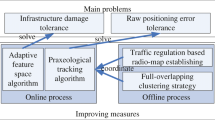Abstract
The Fingerprint-based positioning technique provides an alternative choice for positioning. In order to meet different requirements for traveling, e.g., positioning within a specific area or detection some approaching Point Of Interests (POIs), a Signal-Aware Fingerprint-based Positioning Technique (SAFPPT) is proposed in this paper. SAFPPT contains four positioning methods based on the signal/information of cellular network’s base stations: (i) Positioning Method of Line (PMoL), (ii) Positioning Method of Plane (PMoP), (iii) Approaching Detection Method of Point (ADMoP), and (iv) Approaching Detection Method of Line (ADMoL). The basic idea is that SAFPPT uses user’s cellular information to find the best match records in the pre-established Fingerprint database. SAFPPT can be used in different scenarios of the interested area: (i) Point of Interest (point), (ii) road (line), and (iii) region (plane). The experimental results show that (i) the positioning accuracy of PMoL and PMoP are higher than Google’s “My Location”, (ii) some parameters may affect the positioning accuracy of PMoL, e.g., the moving speed of a user and the number of samples of the Fingerprint database, (iii) the stayed time length of a user may affect the positioning accuracy of PMoP, (iv) ADMoP and ADMoL have higher hit rates to determine the corresponding POIs that a user is approaching within the 150-m radius of the approaching range.




























Similar content being viewed by others
References
Oman, H. (1995). Global positioning system, opportunities and problems. IEEE Aerospace and Electronic Systems Magazine, 10(7), 35–39.
Niculescu, D., Nath, B., et al. (2003). Ad hoc positioning system (APS) using AOA. In The 22nd annual joint conference of the IEEE computer and, communications (pp. 1734–1743).
Simsim, M. T., Khan, N. M., Ramer, R., Rapajic, P. B., et al. (2006). Time of arrival statistics in cellular environments. In The 63rd IEEE vehicular technology conference (pp. 2666–2670).
Gustafsson, F. (2003). Positioning using time-difference of arrival measurements. In The 2003 IEEE international conference on acoustics, speech, and, signal processing (pp. 553–556).
Charitanetra, S., Noppanakeepong, S., et al. (2003). Mobile positioning location using E-OTD method for GSM network. In The student conference on research and, development (pp. 319–324).
Spirito, M., Mattiolli, A., et al. (1999). Preliminary experimental results of a GSM mobile phones positioning system based on timing advance. In The IEEE vehicular technology conference (pp. 2072–2076).
Borenovic, M. N., Simic, M. I., Neskovic, A. M., & Petrovic, M. M., et al. (2005). Enhanced Cell-ID + TA GSM positioning technique. In The international conference on computer as a tool (pp. 1176–1179).
Freedman, A., Dilmon, D., Assayag, A., & Deutscher, E., et al. (2012). Prediction based RSS Fingerprinting for positioning and optimization in cellular networks. In The 27th IEEE convention of electrical and electronics engineers in Israel (pp. 1–4).
Beder, C. & Klepal, M., et al. (2012). Fingerprinting based localisation revisited. In International conference on indoor positioning and indoor navigation (pp. 1–7).
Scholl, M. P., Kohlbrecher, S., Sachidananda, V., & Van Laerhoven, K., et al. (2012). Fast indoor radio-map building for RSSI-based localization systems. In Ninth international conference on networked sensing systems (pp. 1–2).
Borkowski, J., Niemela, J., & Lempiainen, J., et al. (2004). Performance of Cell ID+RTT hybrid positioning method for UMTS radio networks. In The 5th European wireless conference (pp. 487–492).
Laitinen, H., Lahteenmaki, J., & Nordstorm, T., et al. (2001). Database correlation method for GSM location. In The IEEE vehicular technology conference (pp. 2504–2508).
Khalaf-Allah, M., Kyamakya, K., et al. (2006). Mobile location in GSM networks using database correlation with bayesian estimation. In The 11th IEEE symposium on computers and, communications (pp. 289–293).
Takenga, C., & Kyamakya, K., et al. (2007). A low-cost Fingerprint positioning system in cellular networks. In The 2nd international conference on communications and networking in China (pp. 915–920).
Lakmali, B. D. S., Dias, D., et al. (2008). Database correlation for GSM location in outdoor & indoor environments. In The 4th international conference on information and automation for sustainability (pp. 42–47).
Fang, S. H., Lin, T. N., Lee, K. C., et al. (2008). A novel algorithm for multipath Fingerprint in indoor WLAN environments. IEEE Transactions on Wireless Communications, 7(9), 3579–3588.
Fang, S. H., Lin, T. N., Lin, P. C., et al. (2008). Location Fingerprint in a decorrelated space. IEEE Transactions on Knowledge and Data Engineering, 20(5), 685–691.
Stelios, A. M. (2011). Blind position location via geometric loci construction. Wireless Personal Communications, 60(4), 665–677.
Ma, Y. W., Lai, C. F., Hsu, J. M., Chen, N. K., Huang, Y. M., et al. (2011). RFID-based positioning system for telematics location-aware applications. Wireless Personal Communications, 59(1), 95–108.
Sanguino, J. E., Tocha, F., Rodrigues, A., et al. (2011). WAW location-based service positioning. Wireless Personal Communications, 53(3), 599–612.
Huang, C. M., Hsieh, T. H., Lin, S. Y., et al. (2011). A Signal-Aware Fingerprint-based positioning technique in cellular networks. In The 14th international conference on network-based, information systems (pp. 325–332).
Acknowledgments
This research is supported by the National Science Council of the Republic of China Taiwan under the contract number NSC 101-2219-E-006-002 and Institute for Information Industry (III).
Author information
Authors and Affiliations
Corresponding author
Rights and permissions
About this article
Cite this article
Huang, CM., Lin, SY. & Hsieh, TH. The Cellular Network’s Signal-Aware Fingerprint-Based Positioning Technique (SAFPPT). Wireless Pers Commun 75, 233–260 (2014). https://doi.org/10.1007/s11277-013-1359-6
Published:
Issue Date:
DOI: https://doi.org/10.1007/s11277-013-1359-6




